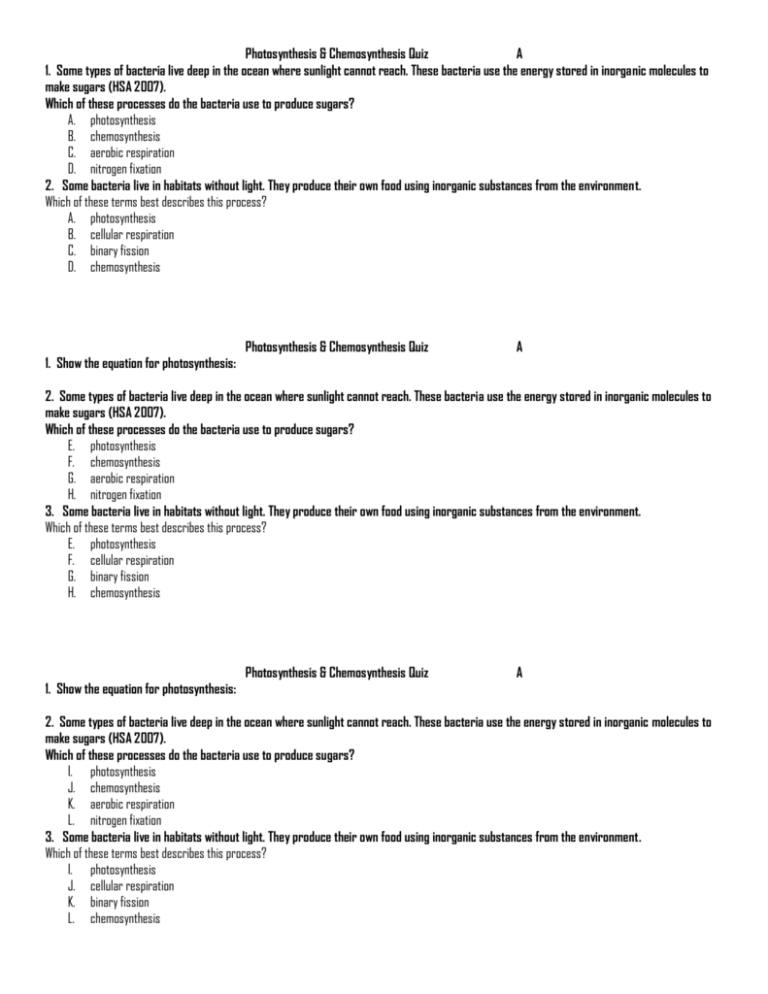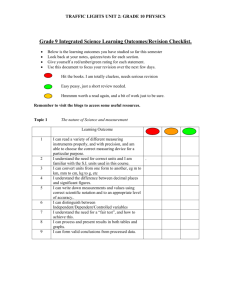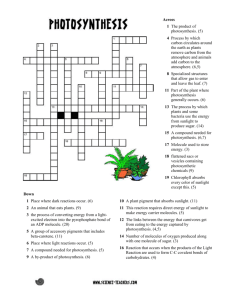5.3-BIO-ENERGY-QUIZ-chemosynthesis
advertisement

Photosynthesis & Chemosynthesis Quiz A 1. Some types of bacteria live deep in the ocean where sunlight cannot reach. These bacteria use the energy stored in inorganic molecules to make sugars (HSA 2007). Which of these processes do the bacteria use to produce sugars? A. photosynthesis B. chemosynthesis C. aerobic respiration D. nitrogen fixation 2. Some bacteria live in habitats without light. They produce their own food using inorganic substances from the environment. Which of these terms best describes this process? A. photosynthesis B. cellular respiration C. binary fission D. chemosynthesis Photosynthesis & Chemosynthesis Quiz A 1. Show the equation for photosynthesis: 2. Some types of bacteria live deep in the ocean where sunlight cannot reach. These bacteria use the energy stored in inorganic molecules to make sugars (HSA 2007). Which of these processes do the bacteria use to produce sugars? E. photosynthesis F. chemosynthesis G. aerobic respiration H. nitrogen fixation 3. Some bacteria live in habitats without light. They produce their own food using inorganic substances from the environment. Which of these terms best describes this process? E. photosynthesis F. cellular respiration G. binary fission H. chemosynthesis Photosynthesis & Chemosynthesis Quiz A 1. Show the equation for photosynthesis: 2. Some types of bacteria live deep in the ocean where sunlight cannot reach. These bacteria use the energy stored in inorganic molecules to make sugars (HSA 2007). Which of these processes do the bacteria use to produce sugars? I. photosynthesis J. chemosynthesis K. aerobic respiration L. nitrogen fixation 3. Some bacteria live in habitats without light. They produce their own food using inorganic substances from the environment. Which of these terms best describes this process? I. photosynthesis J. cellular respiration K. binary fission L. chemosynthesis 4. In deep ocean trenches, bacteria produce organic materials from inorganic compounds through the process of A. B. C. D. respiration decomposition photosynthesis chemosynthesis 5. The energy required for photosynthesis is provided by A. B. C. D. proteins sunlight chlorophyll carbohydrates 6. Explain the difference between chemosynthesis and photosynthesis. (Write your response) 4. In deep ocean trenches, bacteria produce organic materials from inorganic compounds through the process of E. F. G. H. respiration decomposition photosynthesis chemosynthesis 5. The energy required for photosynthesis is provided by E. F. G. H. proteins sunlight chlorophyll carbohydrates 6. Explain the difference between chemosynthesis and photosynthesis. (Write your response) 4. In deep ocean trenches, bacteria produce organic materials from inorganic compounds through the process of I. J. K. L. respiration decomposition photosynthesis chemosynthesis 5. The energy required for photosynthesis is provided by I. J. K. L. proteins sunlight chlorophyll carbohydrates 6. Explain the difference between chemosynthesis and photosynthesis. (Write your response) Photosynthesis & Chemosynthesis Quiz B 1. Some types of bacteria live deep in the ocean where sunlight cannot reach. These bacteria use the energy stored in inorganic molecules to make sugars (HSA 2007). Which of these processes do the bacteria use to produce sugars? M. photosynthesis N. aerobic respiration O. chemosynthesis P. nitrogen fixation 2. Some bacteria live in habitats without light. They produce their own food using inorganic substances from the environment. Which of these terms best describes this process? M. chemosynthesis N. cellular respiration O. photosynthesis P. binary fission 3. Show the equation for photosynthesis: Photosynthesis & Chemosynthesis Quiz B 1. Some types of bacteria live deep in the ocean where sunlight cannot reach. These bacteria use the energy stored in inorganic molecules to make sugars (HSA 2007). Which of these processes do the bacteria use to produce sugars? A. photosynthesis B. aerobic respiration C. chemosynthesis D. nitrogen fixation 2. Some bacteria live in habitats without light. They produce their own food using inorganic substances from the environment. Which of these terms best describes this process? A. chemosynthesis B. cellular respiration C. photosynthesis D. binary fission 3. Show the equation for photosynthesis: Photosynthesis & Chemosynthesis Quiz B 1. Some types of bacteria live deep in the ocean where sunlight cannot reach. These bacteria use the energy stored in inorganic molecules to make sugars (HSA 2007). Which of these processes do the bacteria use to produce sugars? E. photosynthesis F. aerobic respiration G. chemosynthesis H. nitrogen fixation 2. Some bacteria live in habitats without light. They produce their own food using inorganic substances from the environment. Which of these terms best describes this process? E. chemosynthesis F. cellular respiration G. photosynthesis H. binary fission 3. Show the equation for photosynthesis: 4. In deep ocean trenches, bacteria produce organic materials from inorganic compounds through the process of M. N. O. P. respiration chemosynthesis decomposition photosynthesis 5. The energy required for photosynthesis is provided by M. N. O. P. proteins carbohydrates sunlight chlorophyll 6. Explain the difference between chemosynthesis and photosynthesis. (Write your response) 4. In deep ocean trenches, bacteria produce organic materials from inorganic compounds through the process of Q. R. S. T. respiration chemosynthesis decomposition photosynthesis 5. The energy required for photosynthesis is provided by Q. R. S. T. proteins carbohydrates sunlight chlorophyll 6. Explain the difference between chemosynthesis and photosynthesis. (Write your response) 4. In deep ocean trenches, bacteria produce organic materials from inorganic compounds through the process of U. V. W. X. respiration chemosynthesis decomposition photosynthesis 5. The energy required for photosynthesis is provided by U. V. W. X. proteins carbohydrates sunlight chlorophyll 6. Explain the difference between chemosynthesis and photosynthesis. (Write your response)







